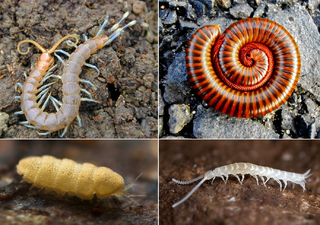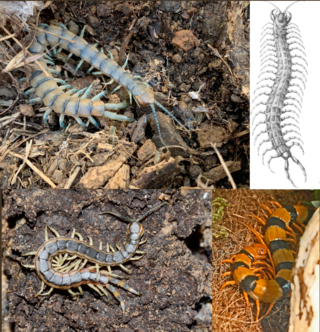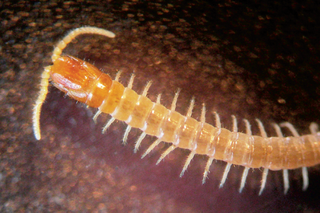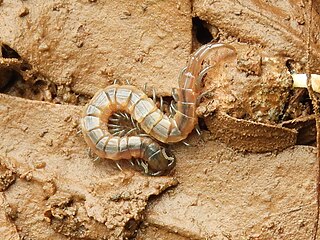
Centipedes are predatory arthropods belonging to the class Chilopoda of the subphylum Myriapoda, an arthropod group which includes millipedes and other multi-legged animals. Centipedes are elongated segmented (metameric) creatures with one pair of legs per body segment. All centipedes are venomous and can inflict painful stings, injecting their venom through pincer-like appendages known as forcipules or toxicognaths, which are actually modified legs instead of fangs. Despite the name, no centipede has exactly 100 pairs of legs; number of legs ranges from 15 pairs to 191 pairs, always an odd number.

Myriapods are the members of subphylum Myriapoda, containing arthropods such as millipedes and centipedes. The group contains about 13,000 species, all of them terrestrial.

The Chinese red-headed centipede, also known as the Chinese red head, is a centipede from East Asia. It averages 20 cm (8 in) in length and lives in damp environments.

Scolopendridae is a family of large centipedes.

Scolopendra is a species-rich genus of large tropical centipedes of the family Scolopendridae.

The Geophilomorpha, commonly known as soil centipedes, are epimorphic and bear upwards of 27 leg-bearing segments. They are eyeless and blind, and bear spiracles on all leg-bearing segments—in contrast to other groups, which usually bear them only on their 3rd, 5th, 8th, 10th, 12th, and 14th segments—a "mid-body break", accompanied by a change in tagmatic shape, occurring roughly at the interchange from odd to even segments. This group is the most diverse centipede order, with 230 genera. Centipedes in this order each have an odd number of leg-bearing segments ranging from 27 to 191. They also have 14–segmented antennae. This order is a monophyletic group including two suborders: the monophyletic Placodesmata, which contains Mecistocephalidae, and Adesmata, which includes the superfamilies Himantarioidea and Geophiloidea. Segment number is usually fixed by species in the family Mecistocephalidae, unlike the case in other families in this order, in which the segment number usually varies within each species. The name "Geophilomorpha" is from Ancient Greek roots meaning "formed to love the earth."

The Craterostigmomorpha are the least diverse centipede clade, comprising only two extant species, both in the genus Craterostigmus. Their geographic range is restricted to Tasmania and New Zealand. There is a single ocellus on each side of the head capsule. They have a distinct body plan; their anamorphosis comprises a single stage: in their first moult, they grow from having 12 trunk segments to having 15. Adult centipedes in this order, like those in Scutigeromorpha and Lithobiomorpha, have 15 leg-bearing segments. Their low diversity and intermediate position between the primitive anamorphic centipedes and the derived Epimorpha has led to them being likened to the platypus. They represent the survivors of a once diverse clade. Maternal brooding unites the Craterostigmomorpha with the Epimorpha into the clade Phylactometria which includes Craterostigmomorpha, Scolopendromorpha, and Geophilomorpha. This trait is thought to be closely linked with the presence of sternal pores, which secrete sticky or noxious secretions, which mainly serve to repel predators and parasites. The presence of these pores on the Devonian Devonobius which is included in own order Devonobiomorpha permits its inclusion in this clade, allowing its divergence of Lithobiomorpha from Phylactometria to be dated to 375 million years ago.

Scolopendra morsitans, also known as the Tanzanian blue ringleg or red-headed centipede, is a species of centipede in the family Scolopendridae. S. morsitans is the type species for the genus Scolopendra.

Scolopocryptopidae is a family of blind centipedes in the order Scolopendromorpha. This family includes more than 90 species. Centipedes in this family are found mainly in the Americas and East Asia but have also been recorded in West Africa, New Guinea, and Fiji.

Himantariidae is a monophyletic family of centipedes in the order Geophilomorpha and superfamily Himantarioidea, found almost exclusively in the Northern Hemisphere. Centipedes in this family feature a short head with a concave labral margin bearing a row of denticles, a single dentate lamella and some pectinate lamellae on each mandible, second maxillae with strongly tapering telopodites and slightly spatulate claws, and a stout forcipular segment with short forcipules and a wide tergite; the ultimate legs usually have no pretarsus, and the female gonopods are distinct and biarticulate.
Dendrothereua is a genus of house centipedes in the family Scutigeridae. There are at least three described species in Dendrothereua, found in the southern United States and the Neotropics.

Scolopendra cataracta is a species of centipede in the family Scolopendridae. It is the first known amphibious centipede, growing to up to 20 centimetres (7.9 in) in length.

Mecistocephalidae is a monophyletic family of centipedes in the order Geophilomorpha. It is the only family in the suborder Placodesmata. Most species in this family live in tropical or subtropical regions, but some occur in temperate regions. This family is the third most diverse in the order Geophiliomorpha, with about 170 species, including about 130 species in the genus Mecistocephalus.
Gonibregmatidae are a paraphyletic family of soil centipedes belonging to the superfamily Geophiloidea.

Plutoniumidae is a family of centipedes belonging to the order Scolopendromorpha. Centipedes in this family are blind and have 21 pairs of legs.

Scolopendra dehaani, common name Giant Vietnamese centipede, is a large Scolopendrid centipede found across Mainland Southeast Asia. It is also found in India, Japan, Hong Kong, and the Andaman and Nicobar Islands.

Scolopendra dawydoffi is a species of large Scolopendrid centipede found in Southeast Asia, specifically in Laos, Vietnam, Thailand, and Malaysia. It has bright reddish-orange and black colouration, and can grow up to and beyond 16 cm in length.

Arthrorhabdus, from the Greek ἄρθρον, a joint, and ῥάβδος, a staff, is a genus of Scolopendrid centipede in the subfamily Scolopendrinae. Species are found in Mexico and the Southern United States, Australia (A. paucispinus & A. mjöbergi), and South Africa (A. formosus). Since a reapprasial in the genus in 2010, the genus only has four species. It may be polyphyletic.
Gonibregmatus is a genus of centipedes in the family Gonibregmatidae. It was described by British entomologist George Newport in 1843.
Gonibregmatus plurimipes is a species of centipede in the Gonibregmatidae family. It was described in 1920 by American myriapodologist Ralph Vary Chamberlin.















